-Dr. Rohini Kitture
This article is about a courageous, determined woman physicist, one of the discoverers of artificial nuclear fission in 1938, overlooked by the Nobel judges that time. The racial, political conspiracies, gender inequality kept her away from immediate recognition she deserved; but the world could no longer ignore her pioneering & influential contributions and named one of the elements in periodic table after her: Meitnerium.
Elsie, later shortened to Lise, was born in a Jewish family in Vienna, Austria in 1878. She was the third of eight children of Philipp Meitner- a reputed lawyer, a renowned chess master and Hedwig Meitner-a talented musician. Despite of the prevailing gender inequality in higher education in those days, Lise Meitner’s parents ensured that each of their daughters receive the same education as their sons and arranged private education in physics for Lise. In 1987, the University of Vienna opened its doors fully to women. 23-year-old Lise enrolled at the University of Vienna in 1901 to study physics and mathematics. She studied with experimentalist Anton Lampa, Stefan Meyer, and the famous theoretician Ludwig Boltzmann, later. In 1906, obtaining doctorate in physics, Lise became the second woman to earn a science PhD in Germany. For her immense interest in radioactivity and nuclear physics, Lise turned down the offer to work in gas lamp industry.
In 1907, Lise moved to Berlin where she approached Max Planck, the young physicist paving his way in quantum theory. Surprisingly, he allowed her to attend his lectures, irrespective of the stringent Prussian law prohibiting women from studying. An impactful turning point in her life! This is where Lise developed collaboration with Otto Hahn who too had keen interest in radioactivity. During this span of 5 years, she worked as an unpaid research scientist, with no access to the laboratories of the Berlin Institute for Chemistry, due to the patriarchal attitudes. Her first research lab was the old wood workshop far away from the teaching section but having a separate access. Regardless of all the hurdles in her research work, Lise discovered several isotopes like protactinium in collaboration with Otto Hahn. This collaboration lasted for almost 3 decades, wherein Lise focused on Physics while Otto on Chemistry part of radioactivity phenomenon.
In 1912, Lise moved to Kaiser Wilhelm Institute (KWI), upon receiving an unpaid guest position in department of Radiochemistry by Otto Hahn. After a year, at the age of thirty-five, Lise got the first paid and permanent position in KWI. This was the period of World War I as well, and Lise volunteered in the Austrian army as an X-ray nurse. After her unwilling return to Berlin, Lise received an offer to head the physics section at the KWI. The relentless dedication to the research in radioactivity by the Meitner-Hahn team became world known and the team got nominated for the Nobel Prize in Chemistry for ten consecutive years from 1924 to 1934. Lise also became the first woman in Germany to assume a post of full professor in physics.
The discovery of the neutron in the early 1930s set the wheels in motion for discovering transuranic elements by bombarding uranium with neutrons in the laboratory. Meitner-Hahn engaged into this research having the global competitors like Ernest Rutherford from Britain, Irène Joliot-Curie from France and Enrico Fermi in Italy, and all these teams believed that the research outcome would bring Nobel Prize. While the radioactivity research was reaching its peak, the political transformations introduced severe hiccups in Lise’s research. Adolf Hitler came to power in 1933, targeting Jews. Although a Jew, her Austrian citizenship could protect Lise. Rest of the eminent Jewish scientist were either dismissed or forced to resign from their posts. Lise continued to bury herself in her research work until 1938, when the situation worsened. She fled to Sweden, with the help of the international physics community and Danish physicist Niels Bohr.
Lise struggled to survive with an exceedingly small salary at the new Nobel Research Institute of Physics for the rest of the war years. While living as an exile because of the Jewish persecution by Nazi Germany, having faced the unsafe and humiliating circumstances, Lise did not deviate from her efforts of unveiling the mystery of transuranic elements. On December 24 of 1938, Hahn mentioned to Lise about “bursting” of uranium to form barium which was in contrast to the expected results. Hahn was aware of the cost to his career in Germany, if included a Jewish scientist’s name in his article, hence he published the results in Die Naturwissenschaften on December 21 omitting Lise from the contributors’ list. Nevertheless, Lise continued to understand the Physics behind the phenomenon, which chemists failed to explain. Lise and nephew Frisch spent hours understanding this puzzling “bursting” process and realized that if the nucleus splits into two unequal parts, the remaining mass might get converted into energy. They termed this as fission, analogous to the biological process of splitting a cell. Lise did calculations using Einstein’s equation E=mc2, to check for the energy yield through this “bursting” process. Thrilled by the results, she urged Frisch to replicate the experiments in his Copenhagen’s laboratories and wrote a series of articles with O.R. Frisch on the nuclear fission of uranium.
The phenomenon having been discovered and reported during the World War II period, the opportunists looked at the phenomenon of fission as a weapon, leading to the establishment of the Manhattan Project in 1942. Instead of grabbing this as an opportunity to gain all the fame, money, recognition, Meitner preferred to refuse the offer to work on the project at Los Alamos, declaring “I will have nothing to do with a bomb!” The Hiroshima incident come as a surprise to her, and she often mentioned that it was tragic that the bomb had to be invented.
Later, at the Royal Institute of Technology in Stockholm, Lise participated in research on R1, Sweden’s first nuclear reactor. Lise got nominated for the Physics Prize three times by Niels Bohr after World War II. Surprisingly, in 1944, Otto Hahn alone was awarded with Nobel Prize for the discovery of the neutron-induced fission of uranium and thorium overlooking Lise who gave the theoretical explanation of the fission process. The racial & gender discrimination, politics and history excluded her from the victory celebration. This was followed by claims by critics as “one of the worst examples of blatant racism and sexism by the Nobel committee.” After the Hiroshima Incident, Eleanor Roosevelt proudly mentioned in an NBC Radio interview with Lise Meitner that “we are proud of your contributions as a woman in science.” Several universities in the United States and Europe bestowed honorary doctorates. Lise was also awarded with Enrico Fermi Prize in 1966. Albert Einstein called this pioneer in nuclear physics “our Madame Curie.”
Having faced the racial conspiracies, the prejudices against women in gaining acceptance/admission to a scientific career, Lise lived her rest of life with tremendous dignity and tenacity, and hardly uttering about the systemic discrimination she encountered. She spent the last few years of her life encouraging women students to “remember that science can bring both joy and satisfaction to your life.”
Lise left the world on October 27, 1968, in Cambridge. Many scientists might have won Nobel Prize; but fewer are those having an element named after them. German physicists Peter Armbruster forever immortalized Lise’s scientific contributions by naming his newly discovered isotope with 109 atoms as Meitnerium, in the honor of the Lise Meitner “to render justice to a victim of German racism and to credit in fairness a scientific life and work”.

(All rights reserved. This article is a joint property of Dr. Rohini Kitture and S&T Digital. No part of this article may be reproduced or used in any manner without written permission.)
References:
https://jwa.org/encyclopedia/article/meitner-lise
https://www.thehindu.com/children/the-meitnerium-mystery/article36014472.ece






It seems Lise never lost immunity as well with humanity, working with radio active elements has higher risk as some of the early scientist got cancer in later stage of there life. God gave her a long life to teach people Science and Social equity. Thanks for sharing this article. Its a weekend read.